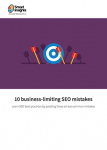Major trends to inform your search marketing actions in 2018 according to James Murray of Bing
In a recent interview with digital marketing agency Impression, James Murray of Bing revealed insights into where Bing see the future of search marketing. This article will discuss each relevant interview and its key takeaways.
Murray discussed a variety of topics from voice search marketing to how links may be decreasing in importance in the future.
Trend 1. Voice Search marketing
Murray discussed how “we’ve bent ourselves as users to conform to the way that search engines behave, resulting in a very robotic style of search”.
- Marketers need to write content for this new set of queries, having the user’s voice in mind as the driving force for creation.
- For example, writing in a way that answers Google’s featured snippets and People Also Ask boxes.
- Think about ways you can markup your content to fit natural language queries.
- Murray discusses changing FAQs from the functional tone they maintain now to one that is more conversational to meet those needs.
Voice search and PPC search marketing
- Campaigns need to incorporate question keywords otherwise voice is going to mean paid ads are going to be left behind.
- There needs to be more investment in broad match to help with these new queries, so businesses should start toying with its functionality now.
Trend 2. Developments in PPC
“We’re moving away from thinking about keywords and are thinking more about audiences.” Says Murray when discussing the future of paid search advertising. Some other key takeaways from this interview were:
- Personal preferences for users will be having more prevalence in SERPs, rather than keywords.
- “Rather than advertisers bidding together in an auction, they have the opportunity to talk to audiences and to make decisions based on those audiences.”
- PPC will change to offer more personalized offers for example, everything will become about the individual to try and encourage loyalty in a brand.
- Audience profiling will take a more prominent role within PPC to fill in the blanks that people leave when searching. For example, an individual may search for ‘plumbers’ but the search engine will bring up local plumbers and potentially traders they have previously contacted.
- The keyword isn’t dead, but users will certainly expect to be able to be more imprecise and for search engines to understand contextually what they’re looking for.
Trend 3. No separate mobile index
While Google has opted for a separate mobile index, Bing is sticking to a device-agnostic approach – marking one of the biggest moves away from Google-alignment for the growing search engine.
- “We think it’s more useful to have an integrated view and to be more device agnostic”
- Focus on personalizing the SERPs for the user not their device.
- Marketers aren’t planning on changing strategies away from mobile due to this information however. The user experience must be at the forefront of development, and this includes making sure mobile is optimised and fast.
- Murray did also state that a separate voice index could be a possible future development however the focus is upon relevance to the user, which will possibly include voice in future.
Trend 4. Future of feed-based advertising
In terms of Bing’s new shopping feed, Murray discussed how “there are a few things on the horizon for changes and tweaks and so one of the things we’re asking advertisers is to really give us as much information as they can in their feeds in order to allow us to offer new ways to use that information in the product.”
- Bing are focussing on amassing as much information as possible to give the user everything they need within the shopping feed.
- This could include price ranges for a product in its different designs and sizes for example.
- There will be a flux of investment into feed-based advertising from both sides of search as it will become even more prominent in future campaigns.
- Companies need to be preparing for this now and developing their feed-based advertising opportunities to create the best possible product ad for the user.
Trend 5. The future of links in search marketing
“What we might see is that links start to decrease in importance that they have in the general context of the various factors that we use to determine relevance.” Murray discussed that links may not be going away anytime soon, but the future holds a decline in relevance for links across search marketing.
- As links are a contributing factor in Bing’s algorithms, Murray discussed personalization as a potential replacement.
- There will be an increased focus on the amount of data gathered from users which will inform the search engine.
- Indicators like search history and live data, or their social context will come into play with search more than links.
- The focus will be on creating SERPs that are relevant and personalized, this will be informed by as much data as possible.
- For the moment, links will still play a key part in ranking factors for sites.
- This increased focus on contextual search is “the absolute next pinnacle of determining relevance” says Murray in the interview.
- In terms of Google, if they choose to use context more, they not only have the greatest market share to be able to gather user insights, but also the access to Analytics data that will no doubt be useful in broader brush contextualization based on more generic traits like country, gender, age of affinity categories.
The complete set of interviews can be found on Impression’s site in their bing interview collection.
For more Digital Marketing trends for 2018, Dr Dave Chaffey gives his expert opinion on his top 10 trends you need to act on in 2018.

